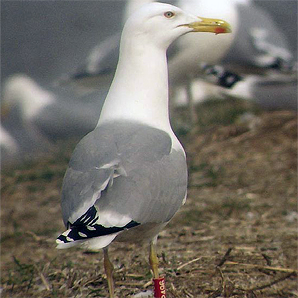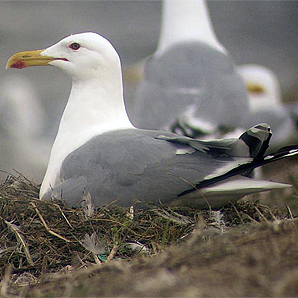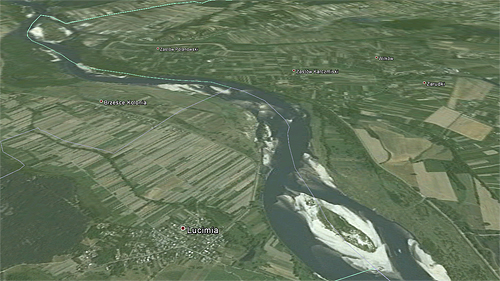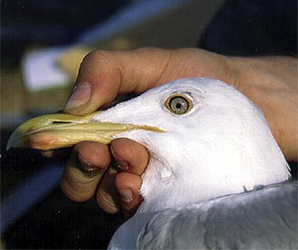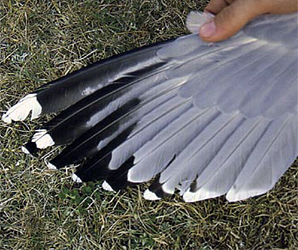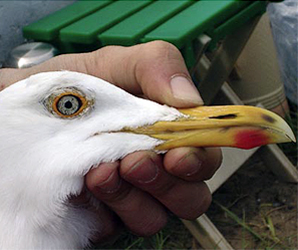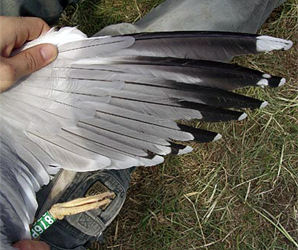 Larus cachinnans
Larus cachinnans
(last update:
Greg Neubauer
Marcin Przymencki
Albert de Jong
Mars Muusse
adult cachinnans: February
Below we continue the the paper by Neubauer et al. in Vogelwelt.
Breeding large gulls in Poland: distribution, numbers, trends and hybridisation.
BY:
Neubauer, G., M. Zagalska-Neuhauer, R. Gwiazda, M. Faber, D. Bukaciriski, J. Betleja & R Chylarecki
IN: Vogelwelt 2006-127: 11-22.
PART 1: INTRODUCTION & METHODS
BELOW PART 2: RESULTS
3. Results
3.1. Distribution and numbers
Large gulls in Poland show a clear distribution pattern (Fig. 1), Herring Gull breeds mainly at the coast, with fewer inland localities confined to lower reaches of Vistula River and lakes in the northern part of the country. Caspian Gull is confined to southern and eastern part of the country, where it breeds on various artificial reservoirs (gravel pits, sedimentation basins, fish ponds and dam reservoirs) and along the middle and upper Vistula. Both species meet in central Poland, where they breed in mixed colonies and form mixed pairs. Yellow-legged Gull has only a marginal influence on Polish population of large gulls, as it remains very rare and local.
Herring Gull Larus argentatus
Since the first breeding record in late 1960s, numbers of argentatus have increased continuously, reaching a maximum of some l,900-2,100 pairs breeding at over 50 localities in 1987-1992. The population as a whole increased exponentially by about 13% per year in the 1970s and by 20% per year in the 1980s, with largest colonies showing annual growth rates between 20% and 60%. Since the early 1990s, the population decreased to more than 1,600 breeding pairs around 1996 (the total of 2,100-2,200 breeding pairs in 1994-96 given in TOMIALOJC & STAWARCZYK 2003 can be an overestimate, produced by summing up maximal numbers from a period of several years), and some 1,200-1,500 pairs in 2003-2004 (surveys by J. ANTCZAK, S. BZOMA & G. KILJAN). The largest colony situated at the Bielawki Islands, Szczecin Lagoon accounted to 900-1,000 pairs in 1991, c. 980 pairs in 1996, but only c. 70 pairs bred there in 2000 with single pairs left in 2002-03. At the same time, smaller colonies have been established on the roof-tops nearby, but they consisted of much less pairs (G. KILIAN, pers. comm.). Two more large argentatus colonies peaked in the 1980s and 1990s and are left nowadays: Vistula mouth near Gdansk (up to 210 pairs 1994-95) and Gardno lake in Slowinski National Park, middle coast (up to 320 pairs in 1985, BEDNORZ 1983; GORSKI et al. 1990). At present, most of the Herring Gull population breeds on roof-tops in towns along the Baltic coast, where birds have moved from natural habitats. The largest roof-top colonies are situated close to the earlier mentioned natural breeding sites; in Ustka (450 pairs in 1996, ZICLKOWSKI 1994; TOMIALOJC & STAWARSZYK, 2003, but only c. 150 in 2004, J. ANTCZAK, pers. comm.) and Gdansk-Gdynia-Sopot agglomeration area (estimated at c. 300 pairs in 2003-04, BZOMA 2001 and S. BZOMA, pers. comm). Inland breeding sites (comprising up to 15 breeding pairs in most cases) are scattered in the northern part of the country (Fig. 1), at lakes and on river islands or in artificial reservoirs. The largest inland colony (which includes up to 30% of Caspian Gulls and hybrids) is located at Wloclawek Reservoir, lower Vistula (see below, Photo 1) and comprised 135-143 breeding pairs in 2002-04. Single individuals and pairs were detected during 1995-2004 at the middle Vistula between Deblin and Kozienice power station with Zastow Karczmiski being the southernmost locality currently known.
Caspian Gull Larus cachinnans
The first few breeding pairs were recorded in 1981-82 at the middle Vistula. Originally, they were reported as Herring Gulls sensu lato (WESOLOWSKI et al. 1984), but subsequently were identified as cachinnans (BUKACINSKI et al. 1989; DUBOIS et a., 1990), although identity of these birds remained controversial (EIGENHUIS 1990; CHYLARECKI & SIKORA 1991; DUBOIS & STAWARCZYK 1991; EIGENHUIS 1991). Middle Vistula was the only place, where the putative Caspian Gull bred regularly until 1992, when the colony of unequivocal cachinnans in Tamow was established (MARTYKA & SKORKA 1999; MARTYKA et al. 2002). A real information boom started in the late 1990s and coincided with a rapid increase in numbers. Breeding sites are now grouped mainly in the southern and eastern part of Poland and especially along middle and upper Vistula; these accounted together for c. 90% of the breeding population in 2004. The largest colonies in 2004 were the island near Zastéw Karczmiski on the middle Vistula with c. 240 pairs (estimated to hold at least 90% of Caspian Gull, R SZEWCZYK et al., pers. comm.; POVTAKIEWICZ et al. in prep.; own data), Jankowice with c. 120 pairs and Mietkow Reservoir with c. 40 pairs. The northernmost breeding site was Wloclawek Reservoir, Lower Vistula. Between 1990 and 2004, Caspian Gulls bred in at least 31 sites (Fig. 1 and Fig. 2), rapidly increasing in numbers to reach a total of 480 breeding pairs in 2004. Between 1997 and 2004, the Polish population of Caspian Gulls showed an exponential growth, with an annual rate of increase of 33% (Fig. 2).
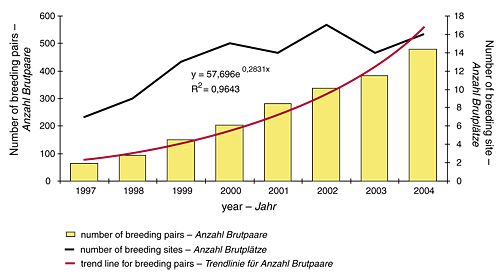
Fig. 2: Caspian Gull increase in Poland, 1997-2004.
Yellow-legged Gull Larus michahellis
Until now, breeding of this species has been proven at six sites (Fig. 1): Mietkéw Reservoir, Lower Silesia - single pairs in 1998 (POLA et al. 1998) and 2001; Nysa Reservoir, Lower Silesia - mixed pair with Caspian Gull in 2000-2001 (TOMIALOJC & STAWARSZYK 2003); Tarnéw - three females trapped on two different nests in 2000 (including female-female pair, BETLEJA et al. in prep.); Jankowice, where two males were trapped in 1999 and 2001 (FABER et al. 2001), a female paired with a male Caspian Gull was found in 2003 (raised three young) and a female ringed as a chick in Italy - Basson, Porto Tolle, Rovigo (May 25 1997; 44°58’N, 12°32`E) was caught on the nest in 2004 (again a female-female pair, with Caspian Gull); Wloclawek Reservoir with single female trapped at the nest in 2003 and seen again breeding next year. The only small “population” breeding regularly was present in 1995-1999 at the middle Vistula islands between Deblin and Kozienice power station: 1-3 breeding pairs were observed every year and 10 birds were trapped in total on the nests (Fig. 1, Fig. 3). After 1999, these birds probably moved to the newly established colony near Zastéw Karczmiski (c. 70 km south of previous breeding sites), where in 2004 an alarming pair, probably with chicks nearby, one single bird paired with a Caspian Gull with chicks and one subadult were seen. Currently, it seems that no more than 5-10 pairs of Yellow-legged Gulls breed in Poland, some in mixed pairs with Caspian and Herring Gulls.
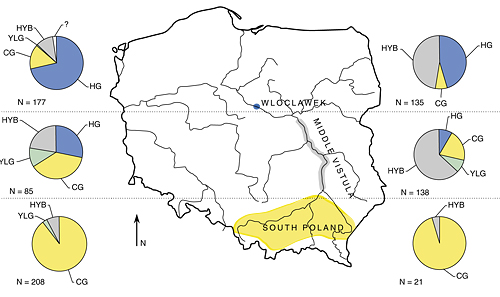
Fig. 3: Species structure in local large gulls populations, based on trapped birds (left side) and pair composition (right side) within the north-south gradient in Poland. HG = Herring Gull (individuals left, pairs right), CG = Caspian Gull, YLG = Yellow-legged Gull, HYB = hybrids or mixed pairs, ‘?’ = not identified individuals.
3.2. Hybrid zone
Until now, the most precise data about hybridisation come from three areas: Wloclawek Reservoir (‘northern zone’), middle Vistula River (‘central zone’) and southern-Polish area (‘southern zone’). Hybridisation between the three forms is proven here by the presence of hybrids among trapped birds and mixed pairs (of which many are trapped as well; see methods). In general, mixed pairs are most common at the middle Vistula, where species composition is most balanced, with none of the species strongly predominating (Fig. 3); they are twice less common at Wloclawek Reservoir where Herring Gull makes up c. 70% of the population. Again in southern Poland, where Caspian Gull dominates (90%), mixed pairs remain rare. This pattern suggests that mating is apparently random with respect to species identity (see below), with the frequency of interspecific pairs being roughly proportional to the frequency of various taxa in the local mate pool. The hybrid zone was inhabited by approximately 350-400 breeding pairs in 2003-04.
3.2.1. Population size in the hybrid zone
The first two nests at Wloclawek Reservoir were found in 1985, followed by a continuous increase in colony size, reaching 32 pairs in 1990, c. 60 pairs in 1993, 116 pairs in 1998 and fluctuating between 133 and 143 pairs in the subsequent years. Caspian Gull numbers are still increasing at Wloclawek Reservoir, with more birds and pairs observed each year, which is consistent with its range expansion.
The middle Vistula population initially increased strongly, from one pair in 1981-82 to 29 pairs in 1993 (BUKACINSKI & BUKACINSKA 1994) and 55-60 in 1998, but almost disappeared in 2002-04, when only 3-5 pairs remained. At the same time, a new colony was established in middle Vistula, c. 70 km south of the area occupied previously, where numbers rapidly grew from 5 pairs in 1999 to 240 pairs in 2004 (P. SZEWCZYK, pers. comm.). Among settlers in the new Zastow colony, there were birds coming from both the north and the south (Fig. 4; see also below).
In southern Poland, the colony in Tarnow was established in 1992 (1 pair) and increased continuously, reaching a maximum of 177 pairs in 2001. Increase in water level caused dramatic decline since 2002, coupled with simultaneous emigration of birds to Jankowice and Zastéw (west and north, Fig. 4). This example also clearly shows the potential for a very rapid colonisation and range extension in Caspian Gulls. Another large colony, in Jankowice, has been established in 1998 (10 pairs) and after a rapid increase appeared to stabilise at c. 120 pairs in 2004.
To summarise, the number of breeding pairs in the hybrid zone still increases, which is mainly the result of range expansion and increasing numbers of Caspian Gulls, The fate of particular colonies remains unstable. Rapidly increasing new colonies, such as the one near Zastow, are inhabited predominantly by Caspian Gulls which immigrated from the south. The local population is mostly homogenous, thus hybridisation frequency should remain at a low level.
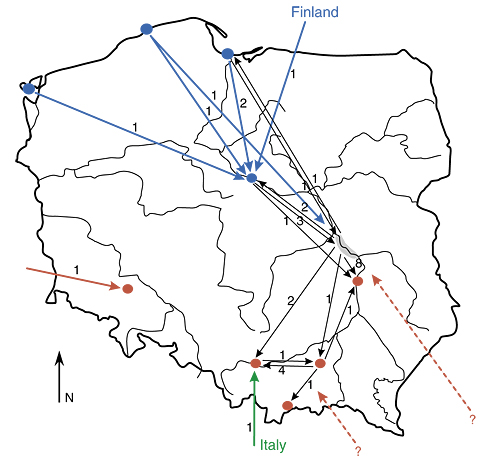
Fig. 4: Origin of foreign settlers in Polish colonies of large gulls and exchange of individuals between colonies within Poland. Numbers given at each arrow represent the number of individuals that moved between colonies and from abroad.
END OF PART 2
CONTINUE PART 3: Population structure and mixed pairing within the north-south gradient
 Larus cachinnans 11CY female U738 February 02 2004, Berlin, Germany. Picture: Ronald Klein.
Larus cachinnans 11CY female U738 February 02 2004, Berlin, Germany. Picture: Ronald Klein. Larus cachinnans hybrid 19CY P432 January - February 2010, Deponie Pohlsche Heide - Minden, Germany (52°23'05N, 08°46'45E).
Picture: Armin Deutsch.
Larus cachinnans hybrid 19CY P432 January - February 2010, Deponie Pohlsche Heide - Minden, Germany (52°23'05N, 08°46'45E).
Picture: Armin Deutsch. Larus cachinnans hybrid 2CY & 5CY 748P February 2006 & January-February 2009, Deponie Pohlsche Heide - Minden, Germany (52°23'05N, 08°46'45E).
Larus cachinnans hybrid 2CY & 5CY 748P February 2006 & January-February 2009, Deponie Pohlsche Heide - Minden, Germany (52°23'05N, 08°46'45E). Picture: Armin Deutsch.
 Larus cachinnans 6CY 231P February 06 2012, Krems, Austria. Picture: Wolfgang Schweighofer.
Larus cachinnans 6CY 231P February 06 2012, Krems, Austria. Picture: Wolfgang Schweighofer. Laruscachinnans 5CY 17P2 February 13 2010, Schachtschleuse - Minden, Germany (52°18'10"N, 08°55'14"E).
Picture: Armin Deutsch.
Laruscachinnans 5CY 17P2 February 13 2010, Schachtschleuse - Minden, Germany (52°18'10"N, 08°55'14"E).
Picture: Armin Deutsch. Larus cachinnans 21P1 8CY-9CY, February 2013 & April 2014, Minden, Germany & Zastow Karczmiski, Poland. Picture: Łukasz Bednarz & Armin Deutsch.
Larus cachinnans 21P1 8CY-9CY, February 2013 & April 2014, Minden, Germany & Zastow Karczmiski, Poland. Picture: Łukasz Bednarz & Armin Deutsch. Larus cachinnans hybrid 4CY-7CY 81P1 December 2009 - November 2012, Roermond, the Netherlands.
Larus cachinnans hybrid 4CY-7CY 81P1 December 2009 - November 2012, Roermond, the Netherlands. Larus cachinnans 5CY 5P45 January 29 - February 03 2009, CET Champteussé-sur-Baconne, France. Picture: Alain Fossé.
Larus cachinnans 5CY 5P45 January 29 - February 03 2009, CET Champteussé-sur-Baconne, France. Picture: Alain Fossé. Larus cachinnans hybrid 9CY 6P18 February 09 2012, Deponie Pohlsche Heide - Minden, Germany (52°23'05N, 08°46'45E).
Picture: Armin Deutsch.
Larus cachinnans hybrid 9CY 6P18 February 09 2012, Deponie Pohlsche Heide - Minden, Germany (52°23'05N, 08°46'45E).
Picture: Armin Deutsch. Herring Gull type Larus argentatus sensu lato P406 adult male, January-February 2013, Barneveld & Amsterdam, the Netherlands.
Herring Gull type Larus argentatus sensu lato P406 adult male, January-February 2013, Barneveld & Amsterdam, the Netherlands. Larus argentatus sensu lato P429 adult, 2012-2013, Zastow Karczmiski, Poland & February 2014, Bucharest, Romania. Likely argentatus.
Larus argentatus sensu lato P429 adult, 2012-2013, Zastow Karczmiski, Poland & February 2014, Bucharest, Romania. Likely argentatus. Larus cachinnans P637 adult, February 19 2015, Alphen aan de Rijn, the Netherlands. Picture: Merijn Loeve.
Larus cachinnans P637 adult, February 19 2015, Alphen aan de Rijn, the Netherlands. Picture: Merijn Loeve.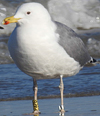 Larus cachinnans PAPB 1CY, 3CY & 8CY, October 2009, January 2011 & February 2016, the Netherlands & Great Britain.
Larus cachinnans PAPB 1CY, 3CY & 8CY, October 2009, January 2011 & February 2016, the Netherlands & Great Britain. Larus cachinnans adult PECX 19 February 2012, Zagreb, Croatia. Picture: Ruud Altenburg.
Larus cachinnans adult PECX 19 February 2012, Zagreb, Croatia. Picture: Ruud Altenburg. Larus cachinnans adult female PEDH February 17 2012, Zagreb, Croatia. Picture: Ruud Altenburg.
Larus cachinnans adult female PEDH February 17 2012, Zagreb, Croatia. Picture: Ruud Altenburg. Larus cachinnans adult PEDN February 17 2012, Zagreb, Croatia. Picture: Ruud Altenburg.
Larus cachinnans adult PEDN February 17 2012, Zagreb, Croatia. Picture: Ruud Altenburg.  Larus cachinnans PNDE adult, February 13 2016, Terschelling, the Netherlands. Picture: Jacob Jan de Vries.
Larus cachinnans PNDE adult, February 13 2016, Terschelling, the Netherlands. Picture: Jacob Jan de Vries.  Larus cachinnans hybrid 6CY-7CY female PLG DN-19343 January 2010 & February 2011, Deponie Pohlsche Heide - Minden, Germany (52°23'05N, 08°46'45E).
Picture: Armin Deutsch.
Larus cachinnans hybrid 6CY-7CY female PLG DN-19343 January 2010 & February 2011, Deponie Pohlsche Heide - Minden, Germany (52°23'05N, 08°46'45E).
Picture: Armin Deutsch.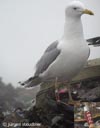 Larus cachinnans adult K862 February 04 2006, Leipzig, Germany. Picture: Jürgen Steudtner.
Larus cachinnans adult K862 February 04 2006, Leipzig, Germany. Picture: Jürgen Steudtner. Larus cachinnans adult K942 February 03 2006, Leipzig, Germany. Picture: Jürgen Steudtner.
Larus cachinnans adult K942 February 03 2006, Leipzig, Germany. Picture: Jürgen Steudtner. Larus cachinnans adult K955 February 04 2006, Leipzig, Germany. Picture: Jürgen Steudtner.
Larus cachinnans adult K955 February 04 2006, Leipzig, Germany. Picture: Jürgen Steudtner. Laruscachinnans adult KH93 February 03 2006, Leipzig, Germany. Picture: Jürgen Steudtner.
Laruscachinnans adult KH93 February 03 2006, Leipzig, Germany. Picture: Jürgen Steudtner. Larus cachinnans 15CY & 17CY female 7E November 19 2011 & February 13 2013, Minsk, Belarus. Picture: Dmitry Goncharov.
Larus cachinnans 15CY & 17CY female 7E November 19 2011 & February 13 2013, Minsk, Belarus. Picture: Dmitry Goncharov. Larus cachinnans adult, 16 February 2012, Zagreb, Croatia. Picture: Chris Gibbins.
Larus cachinnans adult, 16 February 2012, Zagreb, Croatia. Picture: Chris Gibbins. Larus cachinnans adult, 19 February 2012, Zagreb, Croatia. Picture: Mars Muusse.
Larus cachinnans adult, 19 February 2012, Zagreb, Croatia. Picture: Mars Muusse. Larus cachinnans adult, 19 February 2012, Zagreb, Croatia. Picture: Mars Muusse.
Larus cachinnans adult, 19 February 2012, Zagreb, Croatia. Picture: Mars Muusse. Larus cachinnans adult, 19 February 2012, Zagreb, Croatia. Picture: Mars Muusse.
Larus cachinnans adult, 19 February 2012, Zagreb, Croatia. Picture: Mars Muusse. Larus cachinnans adult, 19 February 2012, Zagreb, Croatia. Picture: Mars Muusse.
Larus cachinnans adult, 19 February 2012, Zagreb, Croatia. Picture: Mars Muusse. Larus cachinnans adult, 19 February 2012, Zagreb, Croatia. Picture: Mars Muusse.
Larus cachinnans adult, 19 February 2012, Zagreb, Croatia. Picture: Mars Muusse. Larus cachinnans adult, 19 February 2012, Zagreb, Croatia. Picture: Mars Muusse.
Larus cachinnans adult, 19 February 2012, Zagreb, Croatia. Picture: Mars Muusse. Larus cachinnans adult, 19 February 2012, Zagreb, Croatia. Picture: Mars Muusse.
Larus cachinnans adult, 19 February 2012, Zagreb, Croatia. Picture: Mars Muusse. Larus cachinnans adult, February 26 2011, Ashdod, Israel. Picture: Amir Ben Dov.
Larus cachinnans adult, February 26 2011, Ashdod, Israel. Picture: Amir Ben Dov. Larus cachinnans adult, February 16 2013, Lake of Constance - Altenrhein, Switzerland. Picture: Stephan Trösch.
Larus cachinnans adult, February 16 2013, Lake of Constance - Altenrhein, Switzerland. Picture: Stephan Trösch. Larus cachinnans adult, February 19 2012, IJmuiden, the Netherlands. Picture: Lars Buckx.
Larus cachinnans adult, February 19 2012, IJmuiden, the Netherlands. Picture: Lars Buckx.  Larus cachinnans adult, February 16 2013, Lake of Constance - Altenrhein, Switzerland. Picture: Stephan Trösch.
Larus cachinnans adult, February 16 2013, Lake of Constance - Altenrhein, Switzerland. Picture: Stephan Trösch.  Larus cachinnans adult, February 15 2009, Lake of Constance - Arbon, Switzerland. Picture: Stephan Trösch.
Larus cachinnans adult, February 15 2009, Lake of Constance - Arbon, Switzerland. Picture: Stephan Trösch. 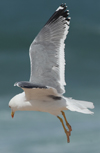 Larus cachinnans adult, February 26 2011, Ashdod, Israel. Picture: Amir Ben Dov.
Larus cachinnans adult, February 26 2011, Ashdod, Israel. Picture: Amir Ben Dov. Larus cachinnans adult, February 26 2011, Eilat, Israel. Picture: Avi Meir.
Larus cachinnans adult, February 26 2011, Eilat, Israel. Picture: Avi Meir.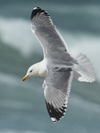 Larus cachinnans adult, February 26 2011, Ashdod, Israel. Picture: Amir Ben Dov.
Larus cachinnans adult, February 26 2011, Ashdod, Israel. Picture: Amir Ben Dov. Larus cachinnans adult, February 09 2011, Ashdod, Israel. Picture: Amir Ben Dov.
Larus cachinnans adult, February 09 2011, Ashdod, Israel. Picture: Amir Ben Dov. Larus cachinnans adult, 19 February 2012, Zagreb, Croatia. Picture: Mars Muusse.
Larus cachinnans adult, 19 February 2012, Zagreb, Croatia. Picture: Mars Muusse.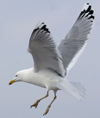 Larus cachinnans adult, 19 February 2012, Zagreb, Croatia. Picture: Mars Muusse.
Larus cachinnans adult, 19 February 2012, Zagreb, Croatia. Picture: Mars Muusse. Larus cachinnans adult, February 03 2012, Eilat, Israel. Picture: Avi Meir.
Larus cachinnans adult, February 03 2012, Eilat, Israel. Picture: Avi Meir. Larus cachinnans adult, 08 February 2013, Eilat, Israel. Picture: Avi Meir.
Larus cachinnans adult, 08 February 2013, Eilat, Israel. Picture: Avi Meir.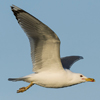 Larus cachinnans adult, 08 February 2013, Eilat, Israel. Picture: Avi Meir.
Larus cachinnans adult, 08 February 2013, Eilat, Israel. Picture: Avi Meir. Larus cachinnans adult, 19 February 2012, Zagreb, Croatia. Picture: Mars Muusse.
Larus cachinnans adult, 19 February 2012, Zagreb, Croatia. Picture: Mars Muusse.